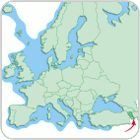 The Republic of Armenia is a small, land-locked country in the Caucasus. Agriculture is the most important sector of Armenia. Cropland areas represent 72% of the total land area. The sector accounts for 33.7% of the GDP. Potato is the main food for 80% of the population. Cereals and vegetables are also major crops in Armenia, but the country is not self-sufficient in cereals.
The Republic of Armenia is a small, land-locked country in the Caucasus. Agriculture is the most important sector of Armenia. Cropland areas represent 72% of the total land area. The sector accounts for 33.7% of the GDP. Potato is the main food for 80% of the population. Cereals and vegetables are also major crops in Armenia, but the country is not self-sufficient in cereals.
Agricultural research in Armenia dates back to the early 1920s. The country became independent only in 1991, and its agricultural research system is today in a transition phase. All the institutions engaged in plant breeding and plant biotechnology belong to the public sector but are under the authority of different Ministries.
Both human and financial plant breeding resources in Armenia are allocated first to roots and tubers and then to cereals. Armenian breeders’ main concern is to increase crop productivity, which is especially low in the country and they work mainly in favourable environments.
Lack of financial resources and an inadequate number of breeders are the most limiting factors for the success of Armenian plant breeding programmes.
Research and education institutes with activities in plant breeding
 |
Laboratory of Cultivated Plants and Their Wild Relatives Genepool, Armenian State Agrarian University
One of the biggest higher educational and scientific centres of Armenia is the State Agrarian University of Armenia (former Armenian Agricultural Academy), founded in 1994. The laboratory is under the authority of the Ministry of Science and Education. Plant breeding activities concern wheat, barley, rye and triticale. Most of the resources are allocated to line development and evaluation.
|
 |
Scientific Centre of Viticulture, Fruit Growing and Wine Making
No Website available
Founded in 1927, this research institute is engaged in plant breeding since its inception, and in plant biotechnology since 1990. Activities concern grapes and other fruits. 60% of its budget is directed to germplasm enhancement. The 40% remaining is equally shared between line development and line evaluation.
|
 |
Scientific Centre of Agriculture and Plant Protection
No website available
Founded in 1926, this research institution is under the authority of the Ministry of Agriculture. In due time, this institute was the biggest centre engaged in cultivation of plants and biotechnology. During more than 70 years of existence very serious tests on cultivation of grain cereals were carried out here. The Institute is engaged by wheat’s cultivation, maize, barley, soybeans, groundnuts, roots and tubers and chickpea. Majority of the budget is dedicated to germplasm enhancement.
|
 |
Scientific Centre of Agrobiotechnology
No website available
This research institute is under the authority of the Ministry of Agriculture. It works mainly on potato varieties. A comprehensive technology which includes the production of high quality potato planting material has been developed. This will help cover the demand of the local seed producers for high quality planting material of potato. Biotechnology has contributed to development and propagation of vegetables and ornamental plants.
|
 |
Scientific Centre of Vegetables and Industrial Crops
No website available
This major research organization was established in 1949 and is under the authority of the Ministry of Agriculture. In due time, this institute became the lead organization engaged in biotechnology. 95% of the institute’s budget is spent on fruits and vegetables while the 5% remaining is spent on grain legumes. The main work consists in line development.
|
 |
Institute of Botany NAS
No website available
Founded in 1939, this research institute is under the authority of the Academy of Sciences. It is engaged for more than 20 years in plant breeding and plant biotechnology. Main activities concern wheat, barley, soybean, tubers, vegetables and fruits. Plant breeding activities consist mainly in line development and evaluation. Biotechnology areas in this organization include tissue culture, wild crosses and fusion and microinjection.
|
 |
Gyumri Breeding Station
No website available
Founded in 1956, this research institute is engaged for more than 20 years in plant breeding and plant biotechnology. These activities concern wheat, barley, soybean, tubers, vegetables and fruits. Plant breeding activities consist mainly in line development and evaluation, and. biotechnology areas include tissue culture, wild crosses, and protoplast fusion.
|
______________________________________
Information by Armine Amyan (2006) - Information based on the Armenia's full report from the PBBC survey.
Last revised 08-03-2010, GIPB
 The Republic of Armenia is a small, land-locked country in the Caucasus. Agriculture is the most important sector of Armenia. Cropland areas represent 72% of the total land area. The sector accounts for 33.7% of the GDP. Potato is the main food for 80% of the population. Cereals and vegetables are also major crops in Armenia, but the country is not self-sufficient in cereals.
The Republic of Armenia is a small, land-locked country in the Caucasus. Agriculture is the most important sector of Armenia. Cropland areas represent 72% of the total land area. The sector accounts for 33.7% of the GDP. Potato is the main food for 80% of the population. Cereals and vegetables are also major crops in Armenia, but the country is not self-sufficient in cereals.






